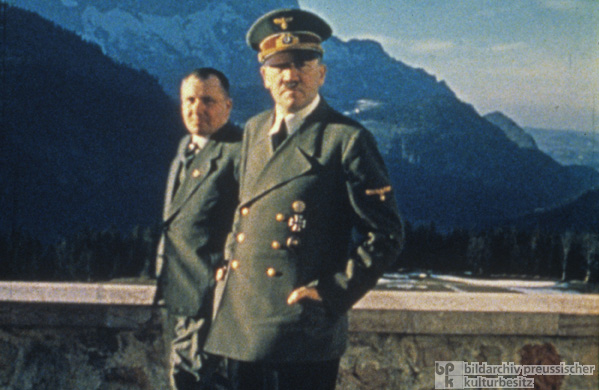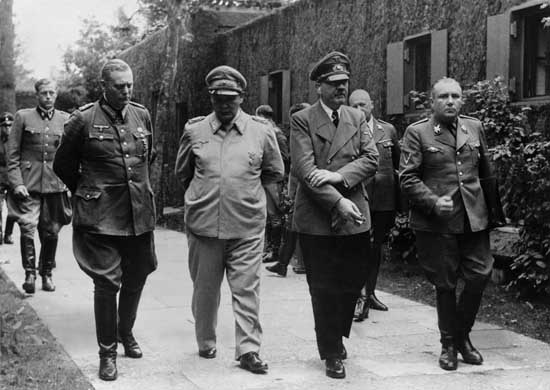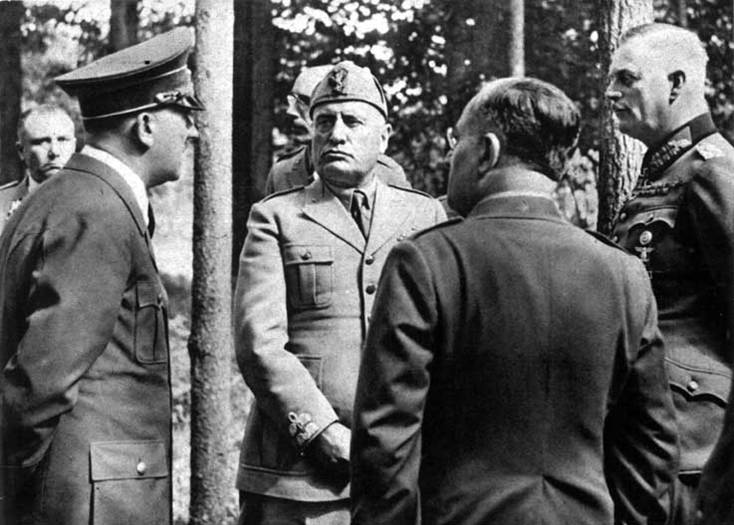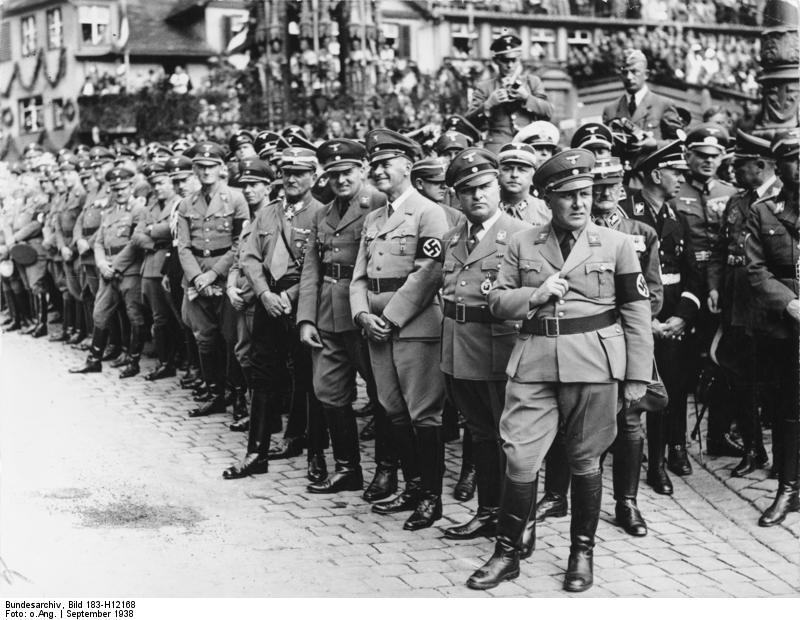<Back to Index>
- Biologist François Jacob, 1920
- Painter Giovanni Paolo Pannini, 1691
- Reichsleiter Martin Ludwig Bormann, 1900
PAGE SPONSOR
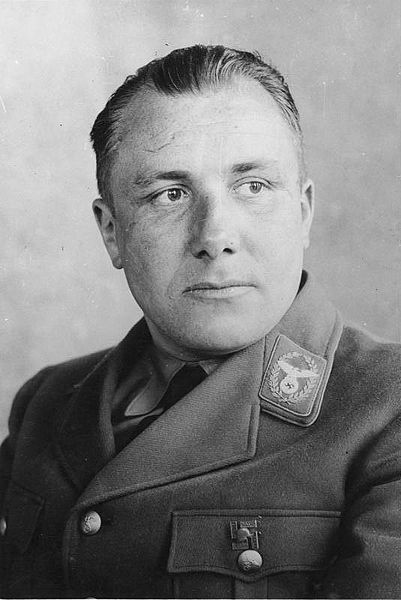
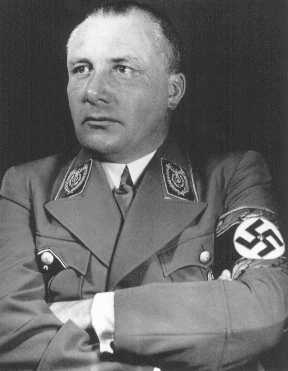
Martin Ludwig Bormann (17 June 1900 – 2 May 1945) was a prominent Nazi official. He became head of the Party Chancellery (Parteikanzlei) and private secretary to Adolf Hitler. He gained Hitler's trust and derived immense power within the Third Reich by controlling access to the Führer and by regulating the orbits of those closest to him.
Born in Wegeleben (now in Saxony - Anhalt) in the Kingdom of Prussia in the German Empire, Bormann was born to a Lutheran family, the son of Theodor Bormann (1862 – 1903), a post office employee, and his second wife, Antonie Bernhardine Mennong. He had two half siblings (Else and Walter Bormann) from his father's earlier marriage to Louise Grobler, who died in 1898. Antonie Bormann gave birth to three sons, one of whom died in infancy. Martin (born 1900) and Albert (born 1902) survived to adulthood.
Bormann dropped out of school to work on a farm in Mecklenburg. He served in an artillery regiment in the last days of World War I, but never saw action. He then became an estate manager in Mecklenburg, which brought him into contact with the Freikorps residing on the estate. He took part in their activities, mostly in assassinations and the intimidation of trade union organisers.
On 17 March 1924, Bormann was sentenced to a year in prison as an accomplice to his friend Rudolf Höss in the murder of Walther Kadow, who they thought had betrayed Freikorps Albert Leo Schlageter to the French during the occupation of the Ruhr District.
On 2 September 1929, Bormann married 19 year old Gerda Buch, whose father, Major Walter Buch, served as a chairman of the Nazi Party Court. Bormann had recently met Hitler, who agreed to serve as a witness at their wedding. Gerda Bormann would give birth to 10 children; one died shortly after birth. Gerda Bormann suffered from cancer in her later years, and died of mercury poisoning on 23 March 1946, in Merano, Italy. All of Bormann's children survived the war. Most were cared for anonymously in foster homes. His eldest son, Martin, was Hitler's godson. Martin abandoned the Lutheran faith of his family and was ordained a Roman Catholic priest in 1953, but left the priesthood in the late 1960s. He married an ex-nun in 1971 and became a teacher of theology.
In 1925, after his release from prison, Bormann joined the NSDAP in Thuringia. He became the party's regional press officer and business manager in 1928. In October 1933, Bormann became a Reich Leader (Reichsleiter) of the NSDAP, and in November, a member of the Reichstag. From July 1933 until 1941, Bormann served as the personal secretary for Rudolf Hess. Bormann commissioned the building of the Kehlsteinhaus (Eagle's
Nest). The Kehlsteinhaus was formally presented to Hitler on 20 April
1938, after 13 months of expensive construction, and is commemorated on
a plaque just above the entrance to the tunnel to the lift up to the
Eagle's Nest. During this period, Bormann had also managed Hitler's
finances through various schemes such as royalties collected on Hitler's book,
his image on postage stamps, as well as setting up an "Adolf Hitler
Endowment Fund of German Industry", which was really a thinly veiled
extortion attempt on behalf of Hitler to collect more money from
German industrialists. In May 1941, the flight of Hess to Britain cleared the way for Bormann to become Head of the Party Chancellery (Parteikanzlei)
that same month. Bormann proved to be a master of intricate political
infighting. Due to his mastery of such infighting, along with his
access and closeness to Hitler, and because of the trust Hitler held in
him, he was able to constantly and effectively check and thus make enemies of Joseph Goebbels, Hermann Göring, Heinrich Himmler, Alfred Rosenberg, Robert Ley, Albert Speer and
a plethora of other high ranking officers and officials, both public
and private. The ruthless and continuous intriguing for power,
influence, and favour from Hitler within the regime came to
characterise the inner workings of the Third Reich. Bormann
took charge of all of Hitler's paperwork, appointments and personal
finances. Hitler came to have complete trust in Bormann and the view of
reality he presented. During one meeting, Hitler was said to have
screamed, "To win this war, I need Bormann!". Many
historians have suggested Bormann held so much power that, in some
respects, he became Germany's "secret leader" during the war. A
collection of transcripts edited by Bormann during the war appeared in
print in 1951 as Hitler's Table Talk 1941 – 1944, mostly a re-telling of Hitler's wartime dinner conversations. Bormann's bureaucratic power
and effective reach had broadened considerably by 1942. Later, faced
with the imminent demise of the Third Reich, he systematically set
about organising German corporate flight capital, and established
off-shore holding companies and business interests in close
coordination with the same Ruhr industrialists
and German bankers who, although often not Nazis, had helped to
facilitate Hitler's explosive rise to power 10 years before. The Nazi view of Christianity was epitomized by Martin Bormann, who, in 1942, stated in a confidential memo to gauleiter that Nazism "was completely incompatible with Christianity." Contrary to Hitler's tactical judgment, Bormann pushed the Kirchenkampf forward at the height of World War II. He
reopened the fight against the Christian churches, declaring in a
confidential memo to Gauleiters in 1942 that their power 'must
absolutely and finally be broken.' Nazism was completely incompatible
with the power of the churches and Christianity whose influence was
regarded by Bormann as a serious obstacle to totalitarian rule. The
sharpest anti-cleric in the Nazi leadership (he collected all the files of cases against the clergy that he could lay his hands on), Bormann was the driving force of the Kirchenkampf, which Hitler for tactical reasons had wished to postpone until after the war. In February 1943, the crushing German defeat at the Battle of Stalingrad produced
a crisis in the regime. Bormann exploited the disaster at Stalingrad,
and his daily access to Hitler, to persuade him to create a three man junta representing the State, the Army and the Party, represented respectively by Hans Lammers, head of the Reich Chancellery, Field Marshal Wilhelm Keitel, chief of the OKW (armed forces high command), and Bormann, who controlled the Party and access to the Führer.
This Committee of Three would exercise dictatorial powers over the home
front. Goebbels, Speer, Göring and Himmler all saw this proposal
as a power grab by Bormann and a threat to their power, and combined to
block it. However,
their alliance was shaky at best. This was mainly due to the fact that
during this period Himmler was still cooperating with Bormann to gain
more power at the expense of Göring and most of the traditional
Reich administration. Göring's loss of power had resulted from an
overindulgence in the trappings of power and his strained relations
with Goebbels made it difficult for a unified coalition to be formed,
despite the attempts of Speer and Göring's Luftwaffe deputy Field Marshal Erhard Milch, to reconcile the two Party comrades. However,
the result was that nothing was done — the Committee of Three declined
into irrelevance due to the loss of power by Keitel and Lammers and the
ascension of Bormann, and the situation continued to drift, with
administrative chaos increasingly undermining the war effort. The
ultimate responsibility for this lay with Hitler, as Goebbels well
knew, referring in his diary to a "crisis of leadership," but Goebbels
was too much under Hitler’s spell ever to challenge his power. Bormann was invariably the advocate of extremely harsh, radical measures when it came to the treatment of
Jews, of the conquered eastern peoples or prisoners of war. He signed
the decree of 9 October 1942 prescribing that "the permanent elimination of the Jews from the territories of Greater Germany can no longer be carried out by
emigration but by the use of ruthless force in the special camps of the
East." A further decree, signed by Bormann on 1 July 1943, gave Adolf Eichmann absolute powers over Jews, who now came under the exclusive jurisdiction of the Gestapo. Bormann's
memos concerning the Slavs make it clear that he regarded them as a
'Sovietized mass' of sub-humans who had no claim to national
independence. In a brutal memo of 19 August 1942 he wrote: "The Slavs
are to work for us. In so far as we do not need them, they may die.
Slav fertility is not desirable." At the Nuremberg Trials, Arthur Seyss - Inquart, the Reich Commissioner for the Netherlands, testified that he had called Bormann to confirm an order to deport the Dutch Jews to Auschwitz, and further testified that Bormann passed along Hitler's orders for the extermination of Jews during the Holocaust. A telephone conversation between Bormann and Heinrich Himmler,
who was his main antagonist in the struggle for power within the Nazi
elite, was overheard by telephone operators during which Himmler
reported to Bormann the extermination of 40,000 Jews in Poland.
Himmler was sharply rebuked for using the word "exterminated" rather
than the codeword "resettled," and Bormann ordered the apologetic
Himmler never again to report on this by phone but through SS couriers. Bormann, his adjutant, SS-Standartenführer Wilhelm Zander, and his secretary, Else Krüger, were with Hitler in the Führer's shelter (Führerbunker) during the Battle of Berlin. The Führerbunker was located under the Reich Chancellery (Reichskanzlei) in the centre government district of Berlin. On 28 April, Bormann wired the following message to German Admiral Karl Dönitz:
"Situation very serious . . . Those ordered to rescue the Führer
are keeping silent . . . Disloyalty seems to gain the upper hand
everywhere . . . Reichskanzlei a heap of rubble." At 04:00 on 29 April 1945, Wilhelm Burgdorf, Joseph Goebbels, Hans Krebs, and Bormann witnessed and signed Hitler's last will and testament. Hitler dictated this document to his personal secretary, Traudl Junge. Bormann was Head of the Party Chancellery (Parteikanzlei) and was also the private secretary to Hitler. Shortly before signing the last will and testament, Hitler married Eva Braun in a civil ceremony. The Soviet forces continued to fight their way into the centre of Berlin. Hitler and Eva Braun committed suicide during the afternoon of the 30 April. Braun took cyanide and
Hitler shot himself in the temple while simultaneously biting a cyanide
capsule. As per instructions, their bodies were taken to the garden and
burned. In accordance with Hitler's last will and testament, Joseph Goebbels, the Minister for Public Enlightenment and Propaganda, became the new "Head of Government" and Chancellor of Germany (Reichskanzler). Martin Bormann was named as Party Minister, thus officially confirming his position as de facto General Secretary of the Party. At 03:15 on 1 May, Reichskanzler Goebbels
and Bormann sent a radio message to Dönitz informing him of
Hitler's death. Per Hitler's last wishes, Dönitz was appointed as
the new "President of Germany" (Reichspräsident). Goebbels and his wife committed suicide later that same day. On 2 May, the Battle in Berlin ended when General der Artillerie Helmuth Weidling, the commander of the Berlin Defence Area, unconditionally surrendered the city to General Vasily Chuikov, the commander of the Soviet 8th Guards Army. It is generally agreed that, by this day, Bormann had left the Führerbunker. It has been claimed that he left with Ludwig Stumpfegger and Artur Axmann as part of a group attempting to break out of the city. As World War II came to a close, Bormann held out with Hitler in the Führerbunker in Berlin. On 30 April 1945, just before committing suicide, Hitler signed the order to allow a breakout. On 1 May, Bormann left the Führerbunker with SS doctor Ludwig Stumpfegger and Hitler Youth leader Artur Axmann as part of a group attempting to break out of the Soviet encirclement. At the Weidendammer Bridge, a Tiger tank spearheaded
the first attempt to storm across the bridge, but it was destroyed.
Bormann and Stumpfegger were "knocked over" when the tank was hit. There
followed two more attempts and on the third attempt, made around 1:00,
Bormann in his group from the Reich Chancellery crossed the Spree. Leaving the rest of their group, Bormann, Stumpfegger and Axmann walked along railway tracks to Lehrter station, where Axmann decided to go alone in the opposite direction of his two companions. When he encountered a Red Army patrol,
Axmann doubled back and later insisted he had seen the bodies of
Bormann and Stumpfegger near the railway switching yard with moonlight
clearly illuminating their faces. He did not check the bodies, so he did not know what killed them. Axmann, Werner Naumann, and their adjutants escaped Berlin. Axmann hid in the Bavarian Alps under the alias "Erich Siewert". He was arrested in December 1945 while organising an underground Nazi movement. Naumann found asylum in Argentina, where he became an editor of the neo-Nazi magazine Der Weg. Lieutenant
General Konstantin Telegin, of the Soviet 5th Assault Army, remembered
his men bringing Bormann’s diary to him. "It was brought in immediately
after the fighting had ended. As far as I can remember, it was found on
the road when they were cleaning up the battle area." Inspired by the
diary and reports from prisoners, Telegin said, "Naturally, we sent a
recon group to the bridge, who searched the site of the breakthrough
attempt. All they found were a few civilians. Bormann was not found." During
the chaotic closing days of the war, there were contradictory reports
as to Bormann's whereabouts. For example, Jakob Glas, Bormann's long time chauffeur, insisted he saw Bormann in Munich weeks after 1 May 1945. The bodies were not found, and a global search followed including extensive efforts in South America. With no evidence sufficient to confirm Bormann's death, the International Military Tribunal at Nuremberg tried Bormann in absentia in October 1946 and sentenced him to death. His court appointed defence lawyer used the unusual and unsuccessful defence that the court could not convict Bormann because he was already dead. In
1965, a retired postal worker named Albert Krumnow stated that around 8
May 1945 the Soviets had ordered him and his colleagues to bury two
bodies found near the railway bridge near Lehrter station. One was "a
member of the Wehrmacht" and the other was "an SS doctor". Krumnow’s
colleague, Wagenpfohl is said to have found a paybook on the SS
doctor’s body identifying him as Dr. Ludwig Stumpfegger. He gave the
paybook to his boss, postal chief Berndt, who turned it over to the
Soviets. They in turn destroyed it. The Soviets allowed Berndt to
notify Stumpfegger’s wife. He wrote and told her that her husband’s
body was "…interred with the bodies of several other dead soldiers in
the grounds of the Alpendorf in Berlin NW 40, Invalidenstrasse 63." In
summer 1965, Berlin police excavated the alleged burial site looking
for Bormann's remains, but found nothing. Krumnow stated he could no
longer remember exactly where he buried the bodies. Stern magazine editor,
Jochen Von Lang, whose investigation inspired the dig, later wrote,
"even if bones had been discovered, it would have been exceedingly
difficult to identify them as those of Martin Bormann." He went on to
opine that the only way to identify Bormann would be to find "glass
particles" from a cyanide capsule in the jaw and that "would border almost on the miraculous."
Unconfirmed sightings of Bormann were reported globally for two decades, particularly in Europe, Paraguay and elsewhere in South America. Some rumours claimed that Bormann had plastic surgery while on the run. At a 1967 press conference, Simon Wiesenthal asserted there was strong evidence that Bormann was alive and well in South America. Writer Ladislas Farago's widely known 1974 book Aftermath: Martin Bormann and the Fourth Reich argued that Bormann had survived the war and lived in Argentina. Farago's evidence, which drew heavily on official governmental documents, was compelling enough to persuade Dr. Robert M.W. Kempner (a
lawyer at the Nuremberg Trials) to briefly re-open an active
investigation in 1972. However, Farago's claims were generally rejected
by historians and critics. Allegations that Bormann and his
organisation survived the war figure prominently in the work of David Emory.
Reinhard Gehlen states in his memoirs his
conviction that Bormann was in fact a Russian agent and that at the
time of his 'disappearance' in Berlin he in reality went over to his
Russian masters and was spirited away by them to Moscow. He bases his conclusion on a conversation he had with Admiral Canaris and
on his conviction that there was an enemy agent at work inside the
German supreme command. He deduced the latter from the fact that the
Russians appeared to be able to obtain "rapid and detailed information
on incidents and top level decision making on the German side". Of
course, at the time he was writing up his memoirs (late 1960s to early
1970s), Gehlen was not aware of the British breaking of the Enigma codes. Gehlen goes on to say that he discovered that Bormann was engaged in a Funkspiel with Moscow with Hitler's express approval. He claims that in the 1950s, when he headed first the Gehlen Organization and later the Bundesnachrichtendienst (BND), the West German Intelligence Service, he "was passed two separate reports from behind the Iron Curtain to the effect that Bormann had been a Soviet agent and had lived after the war in the Soviet Union under
perfect cover as an adviser to the Moscow government. He has died in
the meantime." (quotes from the 1971 ed.) After the collapse of the
Soviet Union, based on KGB archival material from this period, it was claimed that the Russians may indeed have had a spy in the bunker, code named Sasha. The hunt for Bormann lasted 26 years without success. International investigators and journalists searched for Bormann from Paraguay to Moscow and from Norway to Egypt.
Digs for his body in Paraguay in March 1964 and Berlin in July 1964
were unsuccessful. The German government offered a 100,000 Mark reward
in November 1964, but no one claimed it. The final straw came in July
1965 when the search of Albert Krumnow’s Berlin location turned up
nothing. The German government determined that Berlin was simply "too
full of cemeteries and mass graves dating from the last days of the war." On
the political end, the hunt for Bormann became a recurring memory of
the Nazi regime and also an embarrassment that would not go away. On 13
December 1971, the West German government
officially called an end to the search for Bormann. This pronouncement
was met with protest from Jewish human rights groups and Nazi hunters
like Simon Wiesenthal who insisted the search must continue until Bormann was found, alive or dead. Almost
a year later, on 7 December 1972, Axmann and Krumnow's accounts were
bolstered when construction workers uncovered human remains near the Lehrter Bahnhof in West Berlin just 12 metres from the spot where Krumnow claimed he had buried them. Dental records — reconstructed from memory in 1945 by Dr. Hugo Blaschke — identified the skeleton as
Bormann's, and damage to the collarbone was consistent with injuries
Bormann's sons reported he had sustained in a riding accident in 1939.
The second skeleton was deemed to be Stumpfegger‘s, since it was of
similar height to his last known proportions. Fragments of glass in the
jawbones of both skeletons suggested that Bormann and Stumpfegger
committed suicide by biting cyanide capsules to avoid capture. Soon after, in a press conference held by the West German government,
Bormann was declared dead, a statement condemned by Britain's Daily Express as a whitewash perpetrated by the Brandt government.
West German diplomatic officials were given official instruction,
"...if anyone is arrested on suspicion that he is Bormann we will be
dealing with an innocent man.". The remains were conclusively identified as Bormann's in 1998 when German authorities ordered a genetic test on the skull. The test identified the skull as that of Bormann, using DNA from one of his relatives. Bormann's remains were cremated and the ashes scattered in the Baltic Sea by Bormann's son Martin Adolf Bormann, a Roman Catholic and retired priest. Prior
to the DNA tests there had been significant controversy regarding the
authenticity of the remains. For example, Hugh Thomas' 1995 book Doppelgängers claimed there were forensic inconsistencies
suggesting Bormann died later than 1945. When exhumed, Bormann’s
skeleton was covered in flecks of red clay, whereas Berlin is a city
based on yellow sand. This indicated to some that the body had been
re-interred from somewhere with a clay-based soil, such as Paraguay, the Andes Mountains or even Russia (as the Gehlen theory surmised). Nazi hunter Simon Wiesenthal refused
to accept the government’s declaration of Bormann‘s death, persisting
in the belief that Bormann escaped Berlin with Axmann and headed south
to the safety of the Alps. There he was rumoured to have been seen in both Bavaria and Austria. In fact, Bormann’s aide Wilhelm Zander was captured in Passau, along the Austrian frontier, in December 1945. From the Alps, Wiesenthal believed, Bormann and others escaped to South America. Others, like English scholar and intelligence officer Hugh Trevor - Roper,
decried the evidence upon which the German government based its
searches for Bormann: the testimony of one man. He and others argued
that the testimony of Artur Axmann, the only man who said he saw
Bormann dead was falsified to protect Bormann who was then on the run.
Both men were unrepentant Nazis and shared the motivation to keep their
cause alive. Axmann, they argued, probably escaped Berlin with Bormann. Russian investigator
Lev Bezymenski wrote that Axmann’s statements had, "the apparent aim of
convincing the world that the Reichsleiter had been killed." Bezymenski
also wrote that Axmann’s statements, "give rise to a lot of doubt,
especially when one considers that he changed his explanations at least
three times in the postwar years." Some
also believed it implausible that the Soviets would identify the body
of Stumpfegger and ignore Bormann’s body, supposedly at Stumpfegger’s
side. Further, it was said that Bormann was reinterred only to later be
"discovered" by the German government.
